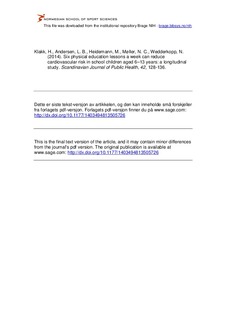| dc.contributor.author | Klakk, Heidi | |
| dc.contributor.author | Andersen, Lars Bo | |
| dc.contributor.author | Heidemann, Malene | |
| dc.contributor.author | Møller, Niels Christian | |
| dc.contributor.author | Wedderkopp, Niels | |
| dc.date.accessioned | 2015-06-01T11:30:23Z | |
| dc.date.available | 2015-06-01T11:30:23Z | |
| dc.date.issued | 2013-09-20 | |
| dc.identifier.citation | Scandinavian Journal of Public Health. 2014, 42, 128-136 | nb_NO |
| dc.identifier.uri | http://hdl.handle.net/11250/284349 | |
| dc.description | I Brage finner du siste tekst-versjon av artikkelen, og den kan inneholde små forskjeller fra forlagets pdf-versjon. Forlagets pdf-versjon finner du på www.sage.com: http://dx.doi.org/10.1177/1403494813505726 / In Brage you'll find the final text version of the article, and it may contain minor differences from the journal's pdf version. The original publication is available at www.sage.com: http://dx.doi.org/10.1177/1403494813505726 | nb_NO |
| dc.description.abstract | Aims: Cardiovascular disease (CVD) originates during childhood and adolescence. Schools are potentially effective settings for early public health prevention strategies. The aim of this study was to evaluate the effect of six physical education (PE) lessons on children’s CVD risk. Methods: This longitudinal study in 10 public schools (1218 children, aged 6–13 years), 6 intervention and 4 control schools evaluates a natural experiment, where intervention schools tripled PE to six lessons per week compared to the mandatory two PE lessons in the control schools. Baseline (2008) and 2-year follow-up measures were anthropometrics, cardiorespiratory fitness, blood pressure and blood samples providing lipids and measures for insulin resistance. Based on these variables, a composite risk score was calculated and used for further analysis. Multivariate multilevel mixed effect regression models were used to estimate effect of intervention taking the hierarchical structure of data into account. Individual, class and school were considered random effects. Intra class correlation (ICC) was calculated. Results: Intervention significantly lowered mean of composite risk score with 0.17 SD (95% CI: −0.34 to −0.01). Six PE lessons per week had a beneficial effect on triglycerides (TG) levels (−0.18 SD, 95% CI: −0.36 to 0.00), systolic blood pressure (SBP) (−0.22 SD, 95% CI: −0.42 to −0.02) and insulin resistance (HOMA-IR) (−0.17 SD, 95% CI: −0.34 to 0.01). Conclusions: Six PE lessons at school can reduce children’s CVD risk measured as a composite risk score. The changes in risk score are considered substantial in the perspective of public health strategy for preventing CVD in later life. | nb_NO |
| dc.language.iso | eng | nb_NO |
| dc.publisher | Sage | nb_NO |
| dc.subject | children | nb_NO |
| dc.subject | CVD risks | nb_NO |
| dc.subject | metabolic health | nb_NO |
| dc.subject | prevention | nb_NO |
| dc.subject | public health | nb_NO |
| dc.subject | school-based | nb_NO |
| dc.title | Six physical education lessons a week can reduce cardiovascular risk in school children aged 6–13 years: a longitudinal study | nb_NO |
| dc.type | Journal article | nb_NO |
| dc.type | Peer reviewed | nb_NO |
| dc.subject.nsi | VDP::Medical disciplines: 700 | nb_NO |
| dc.source.journal | Scandinavian Journal of Public Health | nb_NO |
| dc.description.localcode | Seksjon for idretssmedisinske fag / Department of Sports Medicine | nb_NO |
